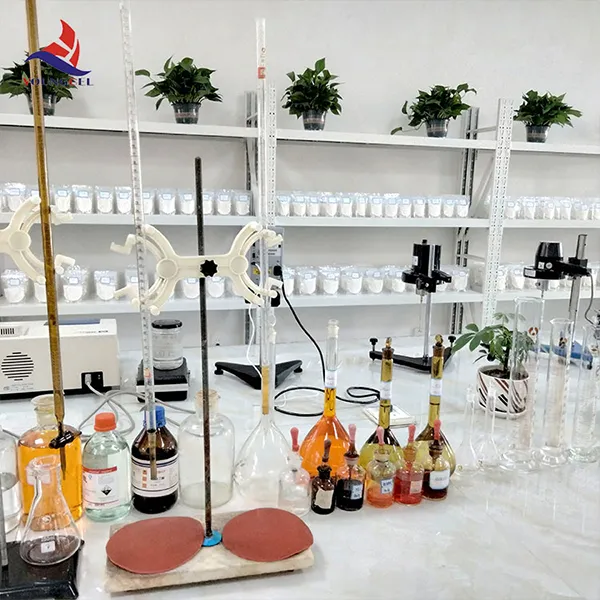Understanding Cellulose Ether The Case of Hydroxyethyl Methylcellulose (HEMC)
Cellulose ether, a crucial polymer derived from cellulose, plays a significant role in various industries due to its versatile properties. Among the various types of cellulose ethers, Hydroxyethyl Methylcellulose (HEMC) stands out. This article delves into the properties, applications, and manufacturing processes associated with HEMC, shedding light on its significance in contemporary industrial practices.
What is Hydroxyethyl Methylcellulose (HEMC)?
HEMC is a non-ionic cellulose ether that is synthesized by the chemical modification of cellulose. This modification involves reacting cellulose with methyl chloride and ethylene oxide, resulting in a polymer with both hydrophilic and hydrophobic characteristics. The introduction of hydroxyethyl groups and methyl groups allows HEMC to exhibit unique solubility properties and enhance its performance in various applications.
The molecular structure of HEMC contributes to its ability to form gels and retain water, making it an essential ingredient in numerous formulations. Its viscosity can be adjusted by changing the degree of methylation and hydroxyethylation, which makes it highly customizable for specific needs.
Applications of HEMC
One of the most prominent applications of HEMC is in the construction industry. Used as a rheology modifier, it improves the workability and efficiency of cement and mortar mixtures. HEMC enhances water retention, ensuring that the mixture remains workable for a longer period, which is critical for large construction projects. Moreover, it helps prevent cracking and shrinkage in plaster and tile adhesives, significantly improving the durability and longevity of construction materials.
In the pharmaceutical and personal care industries, HEMC serves as a thickening agent, stabilizer, and film-forming agent. In cosmetic formulations, it improves the texture and consistency of products such as lotions, creams, and gels. Its non-toxic nature and biocompatibility make it an ideal choice for use in skincare and haircare products. Additionally, HEMC is used in the manufacturing of controlled-release drug formulations, where its gel-forming properties help regulate the delivery of active ingredients.
cellulose ether hemc

Furthermore, HEMC is employed in various food products as a thickening and stabilizing agent. It enhances the viscosity of sauces, dressings, and yogurt, providing a smooth texture without adversely impacting flavor. Its ability to form gels at moderate temperatures also makes it a valuable ingredient in the food industry, catering to the growing demand for clean-label and plant-based formulations.
Environmental Considerations and Safety
As an organic compound derived from natural cellulose, HEMC is considered environmentally friendly. Its production and use align with sustainability goals, as it is biodegradable and does not contribute to environmental pollution. Furthermore, HEMC is typically regarded as safe for use in food and pharmaceutical applications, with regulatory bodies approving its use under specified guidelines.
Manufacturing Process of HEMC
The production of HEMC involves a multi-step process. First, cellulose is extracted from plant sources, which serves as the primary raw material. The extracted cellulose undergoes alkalization, followed by etherification with methyl chloride and ethylene oxide. Following these reactions, the resulting product is washed, dried, and then powdered to the desired particle size.
Quality control is essential in the manufacturing process to ensure that HEMC meets specific viscosity and purity standards. Advanced analytical techniques are employed to assess the physicochemical properties of the final product, ensuring consistency and reliability for manufacturers and end-users alike.
Conclusion
Hydroxyethyl Methylcellulose (HEMC) exemplifies the remarkable versatility of cellulose ethers. Its applications across various industries highlight its significance in improving product quality and performance. As industries continue to evolve, the demand for innovative materials like HEMC will likely grow, paving the way for further research and development in this fascinating field of polymer chemistry. Understanding HEMC is essential for industries aiming to harness its properties effectively, driving advancements in construction, pharmaceuticals, personal care, and food production.
-
Rdp that The Revolutionary Polymer Powder Transforming Modern Construction MaterialsNewsAug.11,2025
-
Hpmc Powder that Versatile Additive for Detergents and Personal CareNewsAug.11,2025
-
Hpmc Hydroxypropyl Methylcellulose that Essential Building Material Additive from Shijiazhuang Gaocheng YongfengNewsAug.11,2025
-
Hydroxypropyl Methyl Cellulos Hpmc that Essential for Construction ApplicationsNewsAug.11,2025
-
Mhec Powder that Revolutionizing Construction Chemistry with Cellulose Ether SolutionsNewsAug.11,2025
-
Industri Hpmc that The Global Backbone of Advanced ConstructionNewsAug.11,2025




